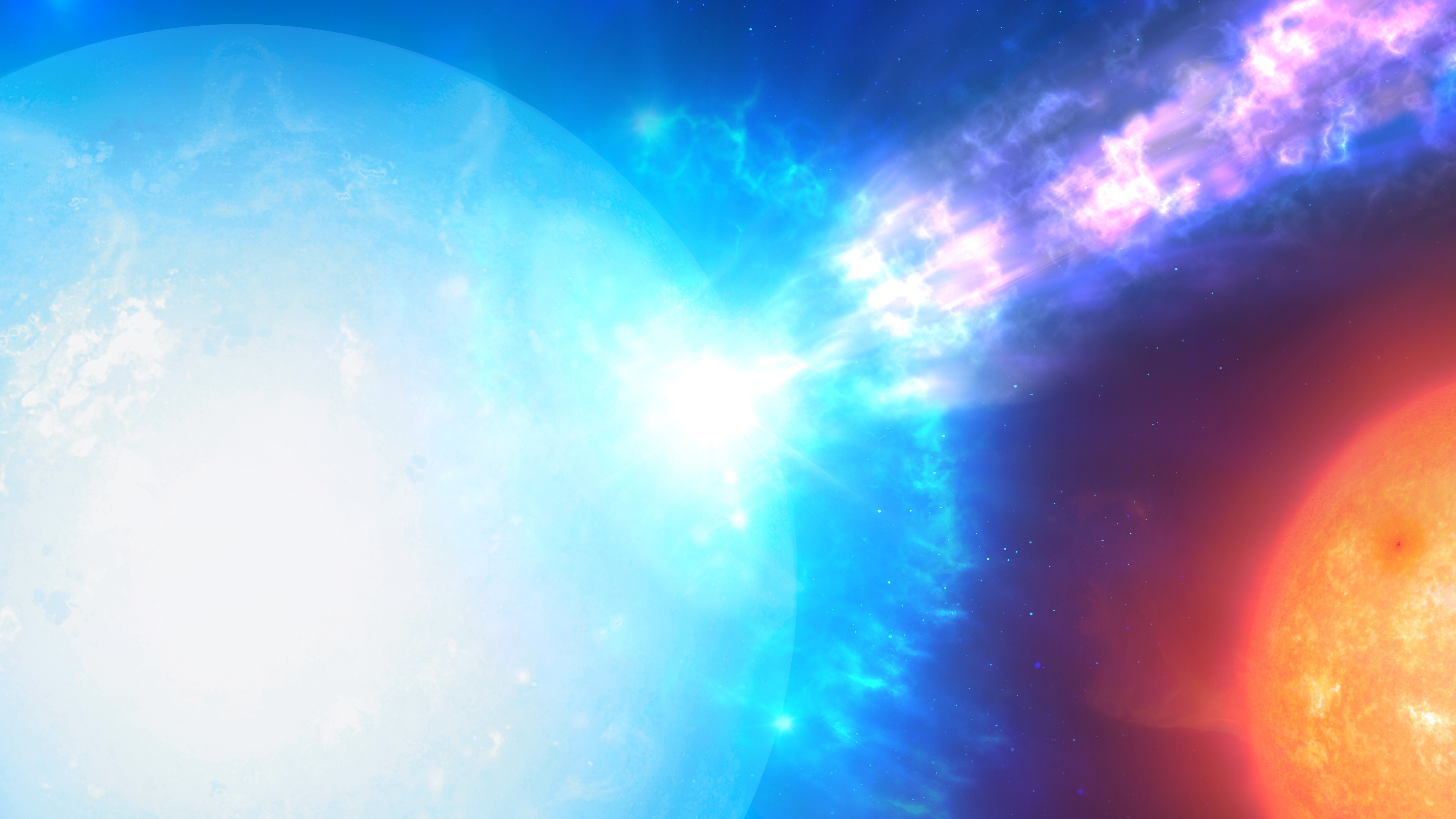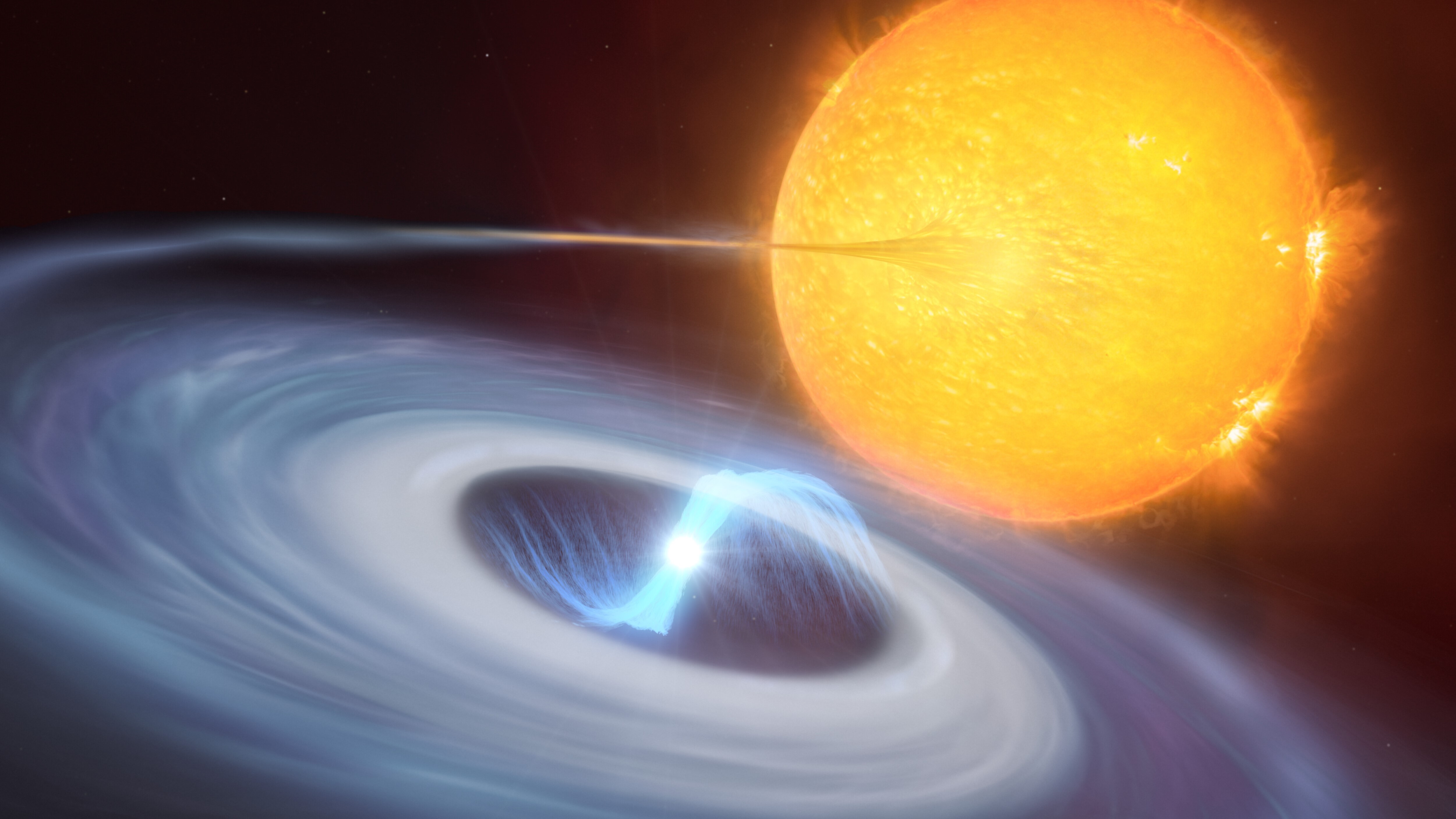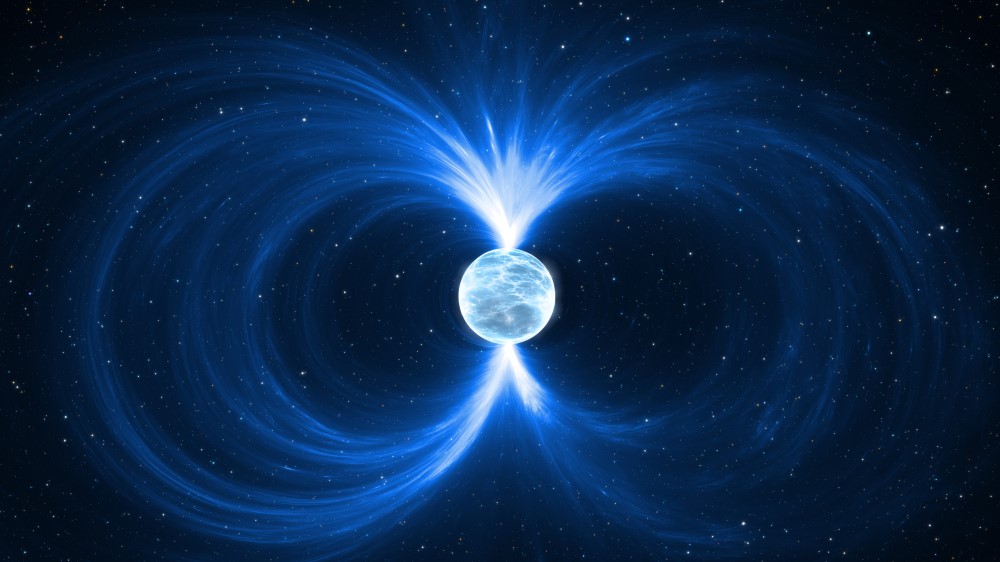Newly discovered 'micronovae' shoot out of the magnetic poles of cannibalistic stars
The cosmic blasts are around a million times less powerful than similar stellar explosions.

Astronomers have detected a never-before-seen type of stellar explosion. The newly discovered cosmic blasts are around a million times less intense than similar explosions and, as a result, the researchers have dubbed the tiny detonations "micronovae."
The new type of "mini" explosion is a variation of a classical nova, a powerful explosion that can occur in binary star systems — where two stars are locked in a stable orbit around one another. In these systems, the more massive partner can strip stellar material from the skin of its more diminutive mate. The superheated plasma that is stripped from the smaller star, which is mainly made of hydrogen, then forms a shell of gas around the more massive star, which slowly blends into the cannibalistic star. However, sometimes this gas can become so dense and hot that it explodes before being absorbed by the large star. The resulting explosion is very powerful and surrounds the entire surface of the star but does not destroy it. Classical novae appear as intense flashes of light that can be detected here on Earth using advanced telescopes; these flashes can persist for several weeks or even months. (Classical novae should not be confused with supernovas, which occur when stars much more massive than the sun collapse and explode completely.)
However, a team of astronomers recently detected a much shorter and less intense flash from a binary system that only lasted 10 hours before it fizzled out. After this observation, the team detected two more similar flashes using the Transiting Exoplanet Survey Satellite (TESS) and discovered evidence of a fourth among previous studies. The astronomers had stumbled upon much smaller versions of classical novae, but they had no way of explaining how or why.
"Initially, we were very surprised," lead researcher Simone Scaringi, an astronomer at Durham University in the U.K., told Live Science. "It took us over a year from discovering these events to have a general idea of what was going on." However, once they realized they had detected a brand new type of stellar explosion it was "very exciting," he added.
Related: Dead stars crashing into live stars may trigger a new type of supernova
But don't let the name fool you: Micronovae still release around 22 quadrillion tons (20 quadrillion metric tons) of material during a single explosion, which is the same mass as around 3.5 billion Great Pyramids of Giza, according to a statement, or around four times the mass of Earth's atmosphere, according to Britannica.
Scientists think micronovae and classical novae only occur in binary systems where the more massive cannibalistic star is a white dwarf — a cool, dim and dense stellar remnant left behind when a star about the size of the sun runs out of hydrogen and helium to fuse together.
Sign up for the Live Science daily newsletter now
Get the world’s most fascinating discoveries delivered straight to your inbox.
"In classical novae, the accreting white dwarf builds a layer of fresh hydrogen that covers the entire star," Scaringi said. "Once this layer reaches high enough temperatures and pressures, the whole layer ignites." However, computer models created by the researchers have revealed that during micronovae, the accretion of hydrogen likely only happens around the star's magnetic poles.

The limited accretion means that a micronova needs much less hydrogen to reach the temperature and pressure needed for detonation. This is why the explosions are much smaller than classical novae and don't last as long.
The study researchers were initially perplexed as to why accreting white dwarfs that produce micronovae only gather hydrogen at their poles. But they now suspect that such accretion is determined by the strength of the stars' magnetic fields.
"We think that the strong magnetic field of the white dwarf keeps the accreted flow of material confined to the magnetic poles, and prevents this flow from spreading across the entire white dwarf surface," Scaringi said. It is similar to how auroras (southern and northern lights) typically occur at magnetic poles on Earth because that is where field lines converge, he added.
The magnetic field needed to contain accretion to a star's poles is likely to be extremely powerful.
"We think that the magnetic field strength required at the surface to keep material confined is of the order of 1-10 million Gauss," Scaringi said. For context, the Earth's magnetic field is between 0.25 to 0.65 Gauss, which is more than a million times weaker than the strength required to contain the mini stellar explosions, according to the International Association of Geomagnetism and Aeronomy. The highest magnetic field strength ever recorded on the sun is around 350 Gauss, according to Live Science's sister site Space.com. However, the magnetic field of most accreting white dwarfs is below the estimated threshold, which is why so many produce classical novae instead of micronovae, Scaringi added.

Despite the magnetic limitations of many accreting white dwarfs, the team suspects that micronovae happen much more frequently than anyone realized.
"These are bright events, but they are also very fast," Scaringi said. "If we are not looking at the right place and at the right time we will miss them." Future studies using TESS may help shine a light on how many of these new mini-explosions actually happen and whether the same stars produce recurring micronovae, which is likely, he added.
The new discovery also opens up the potential to learn more about neutron stars — superdense objects around the size of a city but with the mass of a star, which form when massive stars run out of fuel and collapse.
Neutron stars are known to release large amounts of energy from thermonuclear blasts on their surfaces, which are known as Type 1 X-ray bursts. "Once scaled, both micronovae and Type 1 X-ray bursts look remarkably similar," Scaringi said. This suggests that by finding and studying more micronovae, researchers might be able to learn more about neutron stars as well, he added.
The study was published April 20 in the journal Nature.
Originally published on Live Science.

Harry is a U.K.-based senior staff writer at Live Science. He studied marine biology at the University of Exeter before training to become a journalist. He covers a wide range of topics including space exploration, planetary science, space weather, climate change, animal behavior and paleontology. His recent work on the solar maximum won "best space submission" at the 2024 Aerospace Media Awards and was shortlisted in the "top scoop" category at the NCTJ Awards for Excellence in 2023. He also writes Live Science's weekly Earth from space series.









